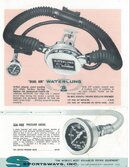I began diving in 1966 and did not routinely use a spg until 1973 when I purchased a USD model. I used a J valve or for shallow water, nothing. I made hundreds of dives with J valve either on my tank or regulator and made many dives in and around 30 feet or less depth with no spg and no J reserve valve. It was common practice and part of dive training to learn to estimate bottom time.
Likewise, neither did I have a BC as they were not in common use either until the early 70s and I still often do not use a BC even for what many would consider fairly advanced level dives. I do not consider a depth gauge a requirement for diving in known depth. Many areas have known bottom depth. All that is required to make such dives is a deco table.
I was 12 years old in 1966, I have been diving continuously since. I began diving solo almost from the beginning as my parents set in the boat drifting above me in 15 to 20 feet of water. I quickly progressed to long shore dives and swims offshore to sites or diving from a little Whaler at my disposal entirely on my own.
Just as most technical so called divers, I do not and did not routinely use a computer until very recently and still only for vacation fun diving. I am fully capable of using a V planner type planning and preplanning a multi level dive and adjusting the profile on the fly.
I have completed many dives in absolute zero viz and dark water on salvage hunts and similar pursuits, known bottom depth, preplanned time. No spg, no depth gauge as I would not have been able to see them anyway. Banging on the boat or some other object alerted me to the passing of time per a preplanned signal routine.
Why did I not purchase a spg until 1973? That year coincides with my move to Valdosta, Ga (spring country) and beginning college and my gaining part time employment in a dive store (and a small employee discount). I met with some older divers who befriended me and taught me cave diving over the next few years. As well, the cost of a spg, was beyond my means until then. And, being as by then, I had more dives than most on this board total, I considered my self sufficiently expert to know what I needed or did not need for a successful dive and still do.
N





